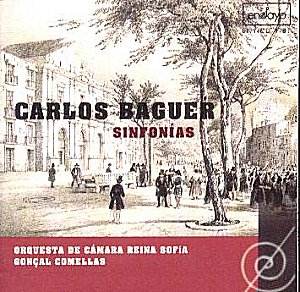The congenial Sinfonias of Catalan organist Carlos
Baguer are steeped in Haydn’s influence. Though he was received into
Holy Orders Baguer renounced religious status at around the turn of
the new century and his compositions show more explicit interest in
instrumental and orchestral than in liturgical music. He did write an
opera in 1798 (The Philosopher Princess), which was produced in Barcelona,
where he spent almost all of his life – but he also essayed the expected
array of classical forms as well as sacred dramas, carols and a sizeable
amount of keyboard music.
Catalans generally preferred three-movement symphonic
form or else one that stressed the rondo or sonata form strength of
the work (and these latter often served as introductions to his oratorios
and operas). Baguer’s three Sinfonías are here undated and
unnumbered. They conform to the prevailing orthodoxy and where
appropriate are spiced with little melodic twists or quirks of orchestration
that keep interest alive. The B flat major for example opens in – as
do most – a form of compressed Haydnesque development but the Andante
con sordini (all three slow movements are con sordini) is somewhat
repetitive though enlivened by a jaunty rising oboe figure accompanied
by cello and bass pizzicati and by the violins’ veiled replies. There’s
more work for the oboe in the Minuetto – a short and attractive movement.
The first of the E flat majors sports some attractive horn harmonies
in the Allegro con brio first movement and attractively yielding melodies
– indeed lyrical fluency is a mark of Baguer’s writing throughout though
due to the compressive nature of the Sinfonias it is never really tested
by developmental potential (and in truth there can be a little repetitiousness
in the writing).
The Orquesta de Camera Reina Sofía comprises
four first violins, four seconds, three violas, two cellos, one bass,
two oboes and one horn and they are a pleasingly alert group. I like
the stately lyricism engendered in the slow movement in the second of
the E flat majors – the longest single movement in all these three works
– even though there is sometimes a feeling that things are a little
unvaried in texture. Nothing shatteringly novel about these works but
they do shed light on a Catalan who sought inspiration in classic central
European models.
Jonathan Woolf

![]() Orquesta de Camera
Reina Sofía/Gonçal Comellas
Orquesta de Camera
Reina Sofía/Gonçal Comellas ![]() ENSAYO CD 9741 [55.19]
ENSAYO CD 9741 [55.19]